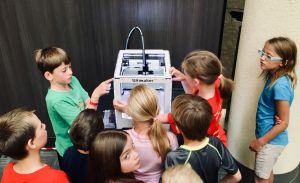“What? That can’t be the bell! Class can’t be over yet!”
~ Deforest, 8th grade
Throughout our teaching careers, we collect memories of interactions with students. Indelible moments! This one happened when Patti was finally teaching her dream class, Creative Thinking, to students at Lakenheath Middle School, England. Deforest was self-nominated as the guy who would drop out of school first. On day one, he entered the classroom (long after the tardy bell) dressed in his Goth-style full-length duster. His hair “concealing” any recognition or emotion. As we moved through lessons on the thinking anatomy and physiology of the brain, creative thinking tools, and finally to animation projects, his creativity erupted. When he shouted out the statement posted above, she did a double-take. Was that really Deforest? This complete reversal of attitude and effort made her even more of a believer. Creativity changes the way ALL students enjoy and interact with the world around them.
So why did we decide to focus on creativity? There came a time when we looked back on our teaching careers and asked, “When were our students the most engaged in their learning? When were we the most engaged in our teaching?” The answer to both was when creativity was involved. This AHA moment motivated us to find out more. We delved into the research supporting the need for creativity in education. Here’s what we discovered: Curiosita Teaching: Why Creativity in Education. The very best news! Creativity is now being recognized on an international level as the most important skill you can teach your students. Elevating and valuing creativity from an “add-on” status that is cool to a necessary and required curricula area of expertise. Our mission was clear. Perhaps Jean Piaget said it best.
“The principal goal of education in schools should be creating men and women who are capable of doing new things, not simply repeating what other generations have done; men and women who are creative, inventive, and discoverers, who can be critical and verify, and not accept everything they are offered.”
NOW
“We do not grow into creativity – we grow out of it. Or rather, we get educated out of it.”
~ Sir Ken Robinson
In 2006, Sir Ken Robinson rocked the world of education with his humorous, thought-provoking TED Talk Do Schools Kill Creativity? It’s been viewed by over 78 million people and translated into 60 languages! If you haven’t seen it, be prepared to be gobsmacked (yes, we did live and teach in England for 7 years). A bit of trivia! We moved to England the year Sir Ken moved to the United States! Fortunately, our paths crossed many times. We had the privilege of talking further with him about the need for creativity in schools. He awakened, in all of us, a renewed spirit for nurturing and protecting children’s “extraordinary capacities for innovation.”
The world is constantly changing, and with those ever-present changes come new problems and situations requiring new ways of thinking and accompanying new ways of teaching and learning. It is no longer a societal need to have learners with large mental storehouses of facts and figures. With the exponential multiplication of data and facts in our world today, many businesses and global leaders recognize the greater need for highly creative and intellectual risk-taking human beings. This video, Why do we Need to be Creative and Critical, demonstrates the importance of creativity (creative and critical thinking) in the 21st century. And beyond! Why it will be even more important for students 20 or 30 years down the road. The message is strong and clear!
School curricula continue to be a reflection of society’s needs and expectations. Emerging alternative “Future-Ready” programs like STEM, STEAM, Personalized Learning, Design Thinking, Project-Based Learning, and Problem-Based Learning have come into existence due to the need to better prepare students for life beyond the school walls. These new programs share common ground in their focus to equip students with the skills and knowledge needed to be successful problem solvers and innovators in the 21st century workforce. Piquing students’ interest and preparing them to work in fields poised for growth. All involve creative processing, methods of inquiry, and investigative skills.
The Global education horizon is directing education towards 21st Century skills. Teaching students how to think critically, problem solve, and providing opportunities for them to use their creativity is the goal of many teachers and educational organizations worldwide. The video, What 60 Schools CanTell Us About Teaching 21st Century Skills, shares the good news! There are programs and promising practices springing up around the globe that include “pieces and parts” of creative teaching in their platforms. Find out what Grant Litchman learned from three months on the road visiting 21 states, 64 schools, and the great ideas of 500 educators. Be prepared to be intrigued with his conceptualization of the Cognito sphere.
HOW
At Curiosita, we believe teachers have been helping students “understand their creative talents and nurture them” since the beginning of teaching. For the most part, they have relied on their somewhat innate teaching talents to make this happen. We’ve all seen them and hopefully experienced demonstrations of their unique talents. Perhaps it was the teacher who assigned you creative project work after you demonstrated quick mastery of content assignments. Unfortunately, this work was oftentimes completed in the hallway and was not an option offered to all students.
After reflecting about the innate talents great teachers bring to our profession, we began toying with the idea that teaching was the missing talent area on Gardner’s Multiple Intelligences framework. We discussed this further with Dr. Robert Marzano in Buenos Aires, Argentina, at the ESSARP conference in 2010. He said it was a fascinating concept and encouraged us to publish it. Patti was intrigued and contacted Dr. Howard Gardner, the creator of the Multiple Intelligences theory. Dr. Gardner emailed that he had “actually mentioned the possibility of a Teaching or Pedagogical Intelligence several times” but time constraints prevented him from pursuing the evidence. We’ve all seen our own “evidence” in the classroom. The teachers who have the “magic” to transform learning creatively for all students!
Now, thanks to people like Sir Ken, ALL teachers are being encouraged to find ways to unleash the creative talents of ALL students. Share this video, Can Creativity Be Taught?, with those still pondering: Creativity: Can’t define it? Can’t teach it? Can’t assess it? Sir Ken begins with a provocative response to those who say creativity can’t be defined. He then goes on to enlighten us on three major concepts many still believe to be false: 1) everyone is born creative, 2) creativity skills can be taught and assessed, and 3) creativity is vital to all our futures. Now more than ever.
“As soon as we can get clear on the issues that creativity can be taught and assessed, we are then in a position to integrate it properly into the entire curriculum. Not as some afterthought but as a way of transforming the power of teaching and learning.”
~ Sir Ken Robinson
The biggest challenge we faced was to make creativity real for teachers. In other words, teachable. So, we were back to the burning question, “How can we teach creativity as an instructional process and embed it into curricular design?” The Curiosita Teaching Framework represents a unique conceptualization for integrating creativity into all teaching and learning. The Creativity-Based Learning Series courses include step-by-step procedures, practices, and organizational support for all stakeholders to make creativity an essential ingredient of all teaching and learning. Built around three teachable components.
- MINDSETS – open-mindedness, risk-taking, perseverance, and growth.
- TOOLSETS – tools, strategies, processes, and graphic organizers.
- SKILLSETS – fluency, flexibility, originality, and elaboration.
Curiosita Creativity-Based Learning Course One is offered in partnership with Central Indiana Education Service Center on KINL.
CBL One: Introduction & Person (45 credits)
Free Sample Curiosity Module (4 credits)
“This course is a treasure trove of practical and classroom-ready ideas. I’m energized and excited to share this new learning with my students and colleagues.”
Corinna Vacarello, Elementary Lead Teacher, Science & Arts Academy, Chicago, IL
WOW
Bring On The Learning Revolution! In this poignant, funny follow-up to his fabled 2006 TED Talk, Sir Ken Robinson makes the case for a radical shift from standardized schools to personalized learning – “creating conditions where kids’ natural talents can flourish.” Quoting Abraham Lincoln, he encourages us to “rise with the occasion” to meet the educational needs of this century. At our meeting in Denver in 2010, his parting comment to us was, “We all need to be a part of the creativity revolution.”

The nature of education is changing drastically on an international level. Educational organizations are beginning to respond to the call from groups and institutions to support the recognition of creativity as a vital component of all school curricula. In an age where digitalized communication and information continue to expand, the path for education lies somewhere in-between blending the powerful learning processes creativity brings to the classroom with the essential content in lessons of instruction.
Using creative processes and strategies add a powerful new dimension to the teaching and learning environment. Teachers will see students practicing and perfecting their work, driven towards meaningful, productive, and creative outcomes. Over time, resulting in the personalization of learning for each student, etching new neural connections and increasing levels of intrinsic motivation . . . a love for learning . . . and in teachers, a renewed inspiration for their craft.
Students’ creativity won’t be cultivated, nurtured, and protected by happenstance. It’s a perishable skill. Today, with more information and resources available, we can change teaching and learning so all students can live and learn creatively! Creativity, once infused, will forever change teaching styles with lessons based upon collaborative experiences between students and teachers. It will also result in a powerful paradigm shift, focusing on what students think, what they say, how they do it, and most importantly, what they produce.
We’ve all been in classrooms where future-minded teachers are making this happen. Unfortunately, they are sometimes viewed as the outliers within their organizations. These teachers have naturally been a part of a movement calling for innovative education reform. They are the shining lights at the end of a long tunnel leading to a foundational shift in the purpose and promise of public education. Protecting and igniting students’ innate creativity.
“If enough people move, it’s a movement. And if the movement is strong enough, it’s a revolution. And that’s what we need.”
~ Sir Ken Robinson
(1950 – 2020)
Moving On!
The conundrums of life are ever-present. For our students to thrive in this new world they will need the innovation skills of the 21st Century: creative thinking, critical thinking, communication, and collaboration. The very ones that enhance their involvement in future-ready programs and prepare them for the unknown challenges they will face.
Sir Ken gave us the vision, and now it’s up to us to adopt it as a mission in words and actions. It can begin on many different levels, in a classroom or as a district-wide initiative. Integrating creativity changes the how (instructional strategies) of teaching (10th Intelligence), not the what (the content). The “difference maker” in preparing our students for personal and professional happiness and success. A future filled with possibilities!
In Case You Missed It!
Divergent Thinking: Pumping Up Students Creative Muscle
Convergent Thinking: Sharpening Students Critical Thinking Skills
We hope we’ve engaged your hearts and minds in both the understanding and belief in the importance of creativity in the future of education. And our students. Please enjoy this copy of our Classroom Creativity Creed.
Live, learn, and lead creatively,
Patti and Rick
Resources
Please login or register to claim PGPs.
Alternatively, you may use the PGP Request Form if you prefer to not register an account.



